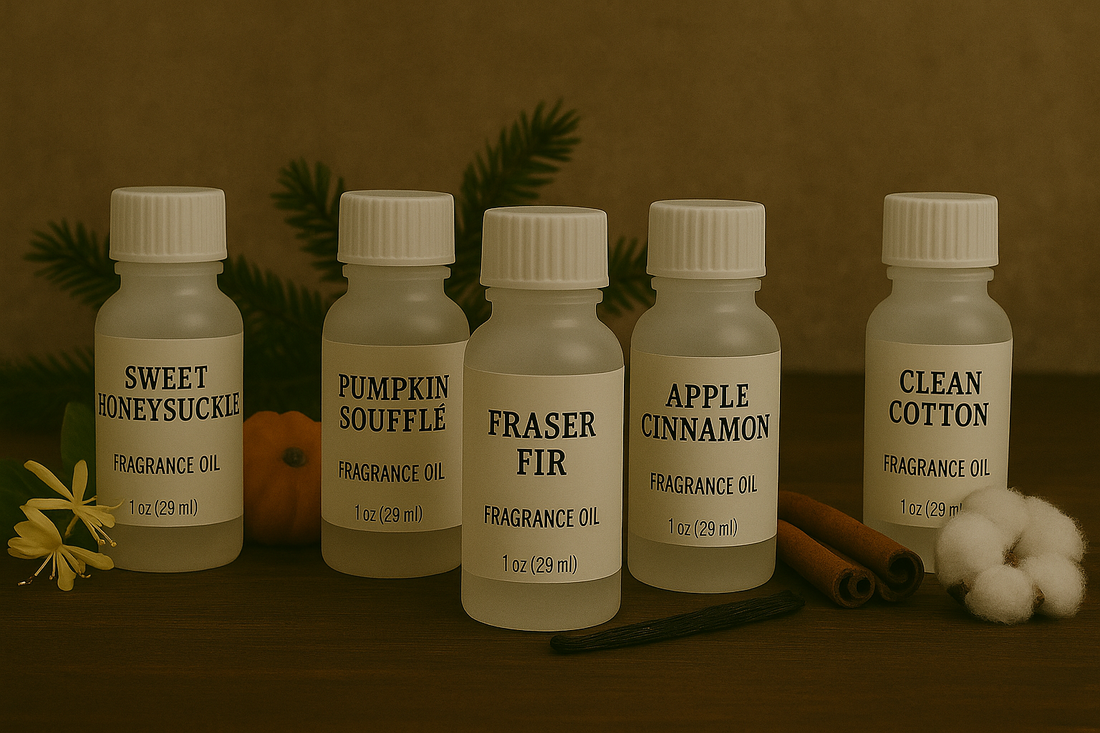
The Complete Fragrance Guide for Candle & Home Fragrance Makers
Share
How to Choose the Right Fragrance Oil for Your Projects
Fragrance is the heart of candle making. It transforms plain wax into an experience—setting the mood, evoking memories, and making a space feel alive. With so many fragrance oils to choose from, it can be overwhelming to know where to start. This guide is designed to answer the most common questions candle makers have about fragrance oils—whether you’re making your very first candle or growing a full product line.
What Are Fragrance Oils?
Fragrance oils are concentrated liquids designed to add scent to candles, wax melts, room sprays, diffusers, and other home fragrance products. They are typically a blend of natural essential oils and synthetic aroma compounds, crafted to provide consistent performance in wax and body-safe applications.
Unlike essential oils alone, fragrance oils are tested for stability, safety, and longevity, making them ideal for candle making.
Fragrance Families
Understanding fragrance families can help you find scents that complement each other and appeal to your target customer:
-
Fruity – Bright, juicy, and uplifting (Macintosh Apple, Georgia Peach, Tropical Orange Blossom).
-
Floral – Romantic and timeless (Gardenia, Sweet Honeysuckle, Hibiscus Guava Fresca).
-
Gourmand – Sweet, edible-inspired scents (Pumpkin Bread, Lemon Pound Cake, Maple Butter Syrup).
-
Woody & Earthy – Grounded, natural notes (Mahogany Teakwood, Cedarwood, Palo Santo).
-
Fresh & Clean – Crisp, energizing aromas (Ocean Mist, Lemon Peel, Eucalyptus).
-
Spiced & Seasonal – Cozy and festive (Spiced Apple Toddy, Mistletoe, Gingerbread Spice Cake).
How Do I Choose the Right Fragrance for My Candles?
Here are a few guiding questions:
-
Who are you making for? – Your personal taste matters, but if you’re selling candles, think about what appeals to your audience. Fall scents (pumpkin, apple, spice) are usually bestsellers, while clean spa-like scents work well year-round.
-
What’s the mood? – Cozy and comforting? Bright and energizing? Romantic and floral? Each fragrance family evokes a different feeling.
-
What’s in season? – Seasonal scents connect to customer emotions and holidays.
-
What format are you making? – Some fragrances shine in candles, while others work best in diffusers or sprays. Always check IFRA usage guidelines.
What Is IFRA and Why Does It Matter?
You’ll notice IFRA certificates listed under many fragrance oils. IFRA (International Fragrance Association) standards outline safe usage levels for fragrances across different applications (candles, soap, body lotion, diffusers, etc.).
-
For candles and wax melts – Typically safe at higher percentages.
-
For body products – Stricter limits apply.
-
Where to find IFRA docs – At Columbus Candle Supply, each fragrance oil page includes its IFRA certificate for your reference.
How Much Fragrance Oil Should I Use?
This is called fragrance load. The amount depends on the wax type and the strength you want:
-
Soy wax – Holds about 6–10% fragrance load.
-
Paraffin or blended wax – Can often hold more (up to 12%).
-
Rule of thumb – About 1.5 oz of fragrance per pound of wax is a safe starting point.
👉 Too much fragrance oil can cause candles not to set properly or burn correctly, so stick to tested ratios.
How Do I Blend Fragrances?
Blending fragrances is where creativity shines. Here are tips to get started:
-
Start with two oils – Smell them side by side in the bottle before mixing.
-
Use a 50/50 ratio to test – Adjust until one scent doesn’t overpower the other.
-
Try complementary families:
-
Fruity + Spicy (Apple + Cinnamon)
-
Woody + Sweet (Cedarwood + Vanilla)
-
Fresh + Floral (Lavender + Lemon)
-
Gourmand + Fruity (Pumpkin + Cranberry)
-
-
Test in wax, not just bottles – Scents can change once they’re heated and cured.
👉 For monthly inspiration, check out our [Mix of the Month], where we share seasonal blend ideas.
Common Questions About Fragrance Oils
Do I need a vendor’s license to shop for fragrance oils?
No! Columbus Candle Supply is open to the public. Anyone can shop with us, in-store or online.
Can I shop tax-exempt?
Yes. Bring a copy of your vendor’s license when shopping in-store, or email it to us for online orders so we can update your account.
Are your fragrance oils skin-safe?
Check the IFRA certificate on each fragrance product page. Many oils are approved for multiple uses, but some are only recommended for candles and home fragrance.
Why does my candle smell weaker when it burns?
This is called hot throw. Some fragrances perform stronger than others in wax. Wax type, cure time, and wick size can all affect the strength.
How long should candles cure before burning?
Soy wax candles usually need 1–2 weeks of curing for the fragrance to fully bond with the wax. Paraffin candles cure faster.
Final Tips
-
Test, test, test – Every wax, wick, and fragrance combination behaves differently.
-
Take notes – Keep a candle-making journal to record ratios, performance, and results.
-
Start small – Buy 1 oz testers before committing to larger bottles.
Ready to Explore?
Browse our [Fragrance Oils Collection] and start experimenting with scents today. Whether you’re making candles, wax melts, diffusers, or room sprays, the right fragrance can transform your product into something unforgettable.
